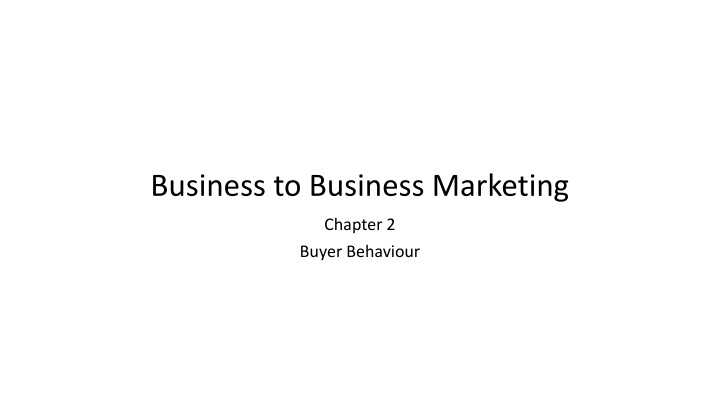
Buyer Behavior in Business-to-Business Marketing
Explore how a company's activities, business strategy, and purchasing orientations influence its interactions with supply markets. Learn about the decision-making unit, the role of purchasing professionals, and the evolving landscape of buying in the digital age. Discover different purchase orientations and how they impact relationships with suppliers.
Download Presentation

Please find below an Image/Link to download the presentation.
The content on the website is provided AS IS for your information and personal use only. It may not be sold, licensed, or shared on other websites without obtaining consent from the author. If you encounter any issues during the download, it is possible that the publisher has removed the file from their server.
You are allowed to download the files provided on this website for personal or commercial use, subject to the condition that they are used lawfully. All files are the property of their respective owners.
The content on the website is provided AS IS for your information and personal use only. It may not be sold, licensed, or shared on other websites without obtaining consent from the author.
E N D
Presentation Transcript
Business to Business Marketing Chapter 2 Buyer Behaviour
Learning outcomes know how the nature of a company s activities and its business strategy affect its dealings with supply markets; understand differing purchasing orientations and their contribution to a customer s acquisition of supplier resources and capabilities be able to explain the buying process and reasons why this process can vary
Learning outcomes be able to describe the membership and characteristics of the decision-making unit know about the job of the purchasing professional understand how buying is evolving in the digital and IoT era
Purchase orientation Buying: lower total spend year-on-year least scope for business marketer to create & share value with customer obtain best deal: maximise power: risk avoidance:
Purchase orientation Procurement: maximise productivity scope for quality improvement: business marketer reduce total cost of ownership to contribute to customer s productivity supplier cooperation focus
Purchase orientation Supply management: maximise value along supply chain firm efforts focused on delivering value to end customers sourcing strategy centred around firm s core competencies & capabilities supply network that efficiently completes required business processes highly collaborative relationships with select supplier & sub-suppliers
Figure 2.1 Segmenting purchase categories high Leverage Strategic exploit buying power or maximise, balance or diversify partnerships develop partnerships profit impact Bottleneck supply security via long-term contracts; multiple suppliers/solutions; broadening of specification Non-critical purchase efficiency via systems buying; e-procurement low Gelderman and van Weele 2003 low supply risk high
Figure 2.2 Purchase decision process determining product specification problem/need recognition product and supplier search performance evaluation and feedback proposals evaluation and supplier selection specification of order routine
Table 2.2 Buying situations and marketer actions Buying situation Modified rebuy (complex:simple) Marketer actions New task Straight rebuy (routine:casual) (strategic:judgemental) Out-supplier track search and communication behaviour; develop customer insight; examine create communications messages to present value adding supply alternatives; deliver messages to match customer search behaviour total cost of ownership; secure purchase and specification information; tailor solutions to specific supply needs target users, designers, engineers In-supplier anticipate, monitor try to move reinforce relationship changing needs; to straight rebuy; regular communication; offer consultation in specifying reduce perceived automated ordering benefits of supply switch supply need
Decision making unit (buying centre) Purchase roles user Influence decision, may be part of DMU affect final decision ref. needs, product & vendors influencer decider buyer makes final decision (may be more than one) makes purchase; administers decision gatekeeper control information in/out of buying group can affect decisions
Figure 2.3 Decision making unit (buying centre) Organisational functions Purchase roles user influencer decider buyer gatekeeper purchasing operations engineering finance r & d marketing
What marketers need to know about DMU in buying process what happens to DMU structure during different phases of process ? - number of participants in DMU - number of functional areas/departments represented - number of hierarchical levels involved in purchase changes likely to affect - communication & influence patterns in DMU - information needs at any given point in time Ghingold and Wilson 1998
Knowledge about DMU in buying process Value to marketers Effective marketing hinges on identifying: key DMU members concerns/needs crafting solutions to: satisfy individual DMU member needs minimise perceived risk early involvement to: reach & influence DMU participants before key decisions are made that will determine vendor choice Ghingold and Wilson 1998






















